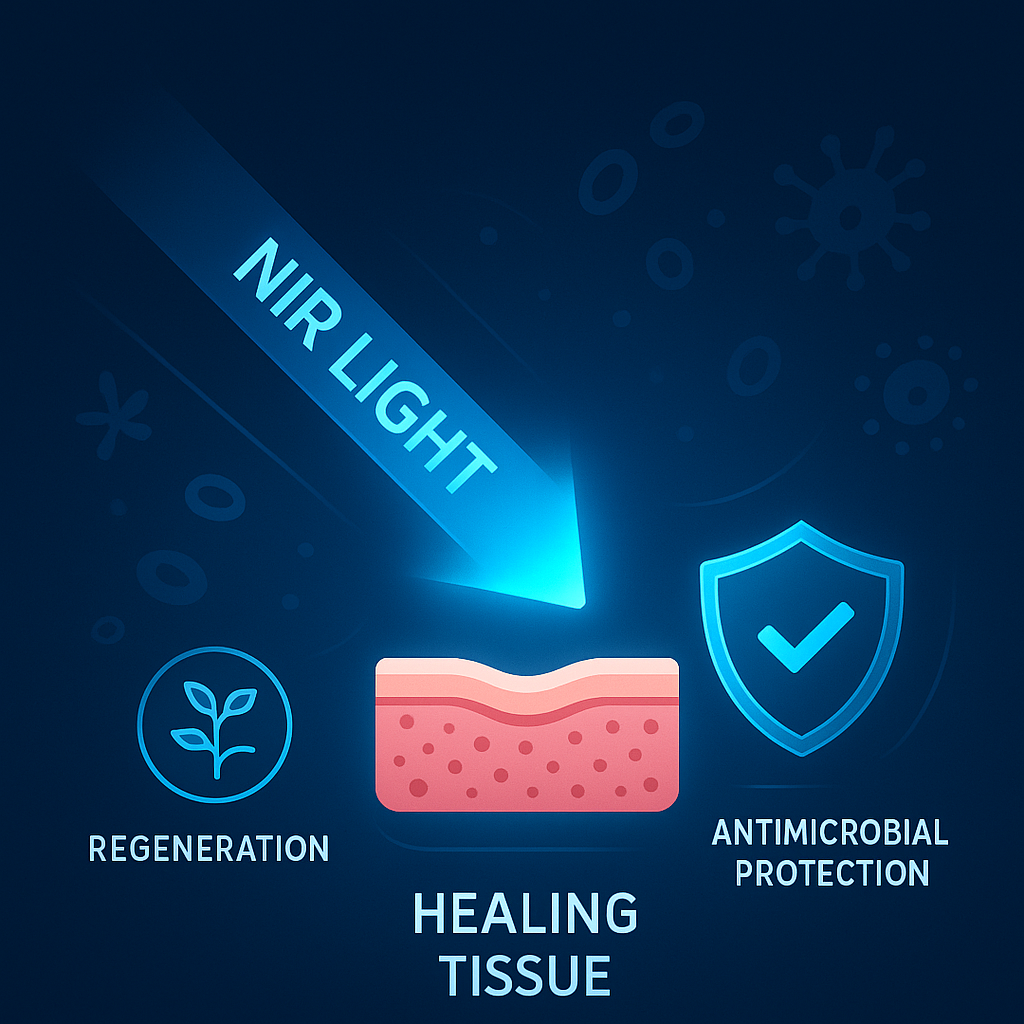High-level technical synopsis
The integration of near-infrared (NIR) technology into regenerative medicine has shown promising advancements, particularly in the utilization of NIR photons within the biological window of 700-1350 nm. This range allows for effective energy propagation through biological tissues with minimal collateral damage. For instance, studies have demonstrated penetration depths of 5 mm for antimicrobial therapies created with 980 nm excitation, significantly improving treatment outcomes without harming surrounding tissues [Han et al., ACS Appl. Bio Mater., 2020].
Photobiomodulation of native cells
Photobiomodulation (PBM) has emerged as a key strategy in enhancing cellular metabolism and tissue repair. Low-fluence NIR irradiation engages mitochondrial chromophores to elevate ATP production, subsequently enhancing micro-perfusion and gene expression related to tissue regeneration. For example, studies have shown that PBM combined with polymer scaffolds significantly boosts callus volume and mineral density in bone repair [Wang et al., Mater. Sci. Eng. C, 2022].
Photothermo-/photodynamic (PTT/PDT) scaffolds
The development of PTT/PDT scaffolds that integrate photothermal transducers and catalytic nanozymes promotes effective pathogen eradication while simultaneously triggering regenerative signaling. Such systems utilize localized heating to disrupt microbial membranes, allowing the dual-action of thermal and chemical responses to enhance healing [Yin et al., ACS Nano, 2016]. Furthermore, studies indicated that enhancing the oxidative capacity through PTT not only boosts antimicrobial efficacy but also positively impacts tissue repair dynamics [Liu et al., Appl. Surf. Sci., 2023].
Representative systems
A variety of NIR-responsive systems have showcased the potential for accelerated wound healing and tissue regeneration. For example, NIR-doped scaffolds have demonstrated effective healing in chronic wounds by promoting angiogenesis and collagen biosynthesis through orchestrated biochemical signals [Zhang et al., J. Phys. Chem. Lett., 2019]. Similarly, glucose-NIR dual-responsive Fenton hydrogels have showcased significant antimicrobial activity while enhancing healing outcomes in tumor models [Hao et al., Biomaterials, 2020].
“Logic-gated” NIR hydrogels and coatings
Innovations such as logic-gated NIR hydrogels have been developed to provide targeted and responsive therapies. These materials utilize detectable biochemical signals (e.g., glucose levels) to modulate their responsiveness to NIR light, thereby controlling the rate of therapeutic release and providing localized treatment in cases of hyperglycemic infections [Hao et al., Biomaterials, 2020]. Such strategies have been proven effective in tailoring therapeutic responses to individual patient needs, enhancing the healing process while minimizing side effects.
Key molecular/regenerative read-outs observed across these platforms
Across NIR-responsive systems, numerous key readouts such as enhanced ALP activity, increased VEGF and TGF-β secretion, and improved collagen deposition have been noted. These readouts not only measure regenerative outcomes but also reflect the biological activity of these advanced scaffolds in promoting tissue repair [Wang et al., Mater. Sci. Eng. C, 2022]. The integration of these biomolecular indicators supports their clinical applicability and underscores the potential for transforming wound healing practices.
Outstanding engineering challenges
There remain several engineering challenges to the clinical translation of NIR technologies. These include optimizing photon dosimetry to ensure safe yet effective energy delivery, creating biodegradable scaffolds to avoid long-term toxicity, and managing host immune responses to prevent chronic inflammation [Wang et al., Mater. Sci. Eng. C, 2022].
Effective solutions will require innovative approaches to balance these key factors while maximizing the therapeutic potential of NIR technologies.
Strategic research directions
Future research directions in NIR theranostics are poised to focus on developing fully degradable materials that maintain high efficacy in photothermal applications. Additionally, embedding multimodal monitoring systems within NIR-responsive hydrogels will facilitate real-time feedback on therapeutic efficacy, promoting individualized patient care [Zhang et al., J. Phys. Chem. Lett., 2019]. The integration of bio-electronic systems that allow for smart therapeutic delivery represents a frontier that could revolutionize wound healing strategies, offering clinicians tools unparalleled in precision and responsiveness.
Conclusion
Through advancements in NIR technologies, regenerative medicine stands at the cusp of a revolution. By creating synergistic systems that balance antimicrobial action and tissue regeneration, researchers enhance patient outcomes in challenging healing scenarios. With ongoing innovation addressing current challenges, the vision of personalized, effective therapeutic strategies becomes increasingly attainable.
Sources
- Mater. Sci. Eng. C – The effect of near-infrared light-assisted photothermal therapy combined with polymer materials on promoting bone regeneration: A systematic review
- ACS Appl. Bio Mater. – Near-infrared light brightens bacterial disinfection: recent progress and perspectives
- WIREs Nanomed. – NIR light‐facilitated bone tissue engineering
- Biomaterials – Near-infrared light and glucose dual-responsive cascading hydroxyl radical generation for in situ gelation and effective breast cancer treatment
- Appl. Surf. Sci. – NIR-II-enhanced single-atom-nanozyme for sustainable accelerating bacteria-infected wound healing
- ACS Nano – Functionalized Nano-MoS2 with Peroxidase Catalytic and Near-Infrared Photothermal Activities for Safe and Synergetic Wound Antibacterial Applications
- J. Phys. Chem. Lett. – Near-infrared light-triggered porous AuPd alloy nanoparticles to produce mild localized heat to accelerate bone regeneration
- ACS Nano – Multifunctional photoactive hydrogels for wound healing acceleration
